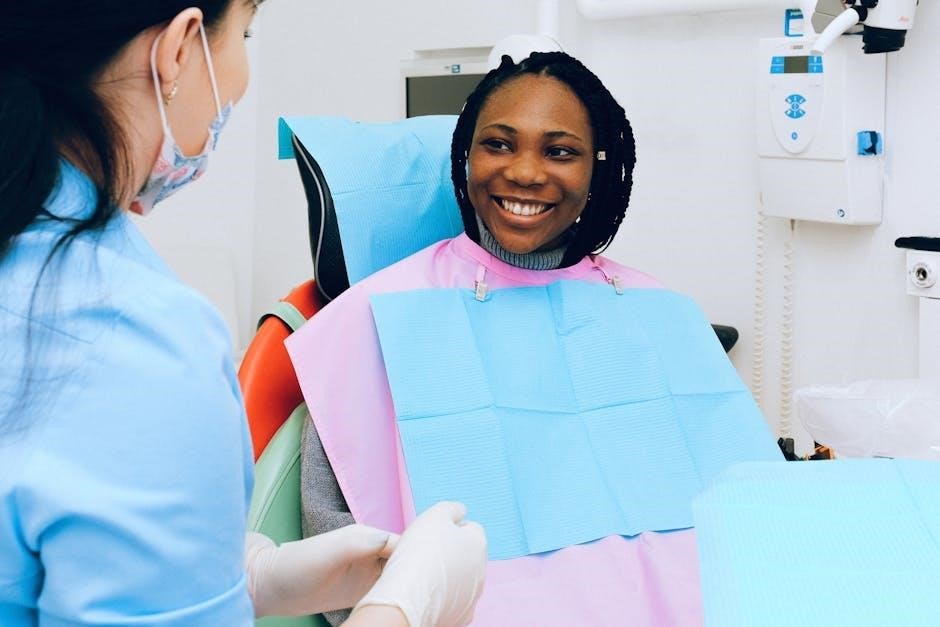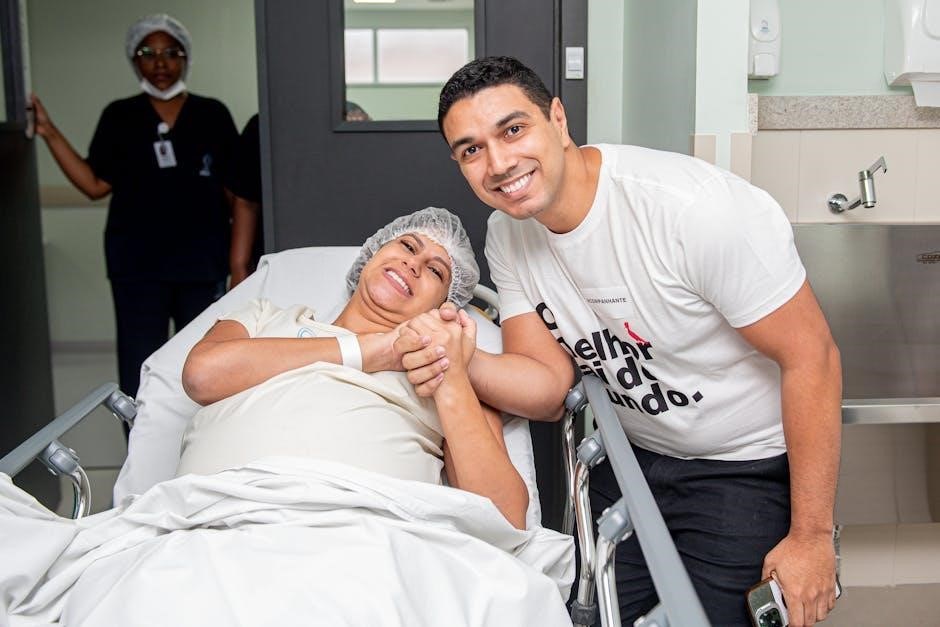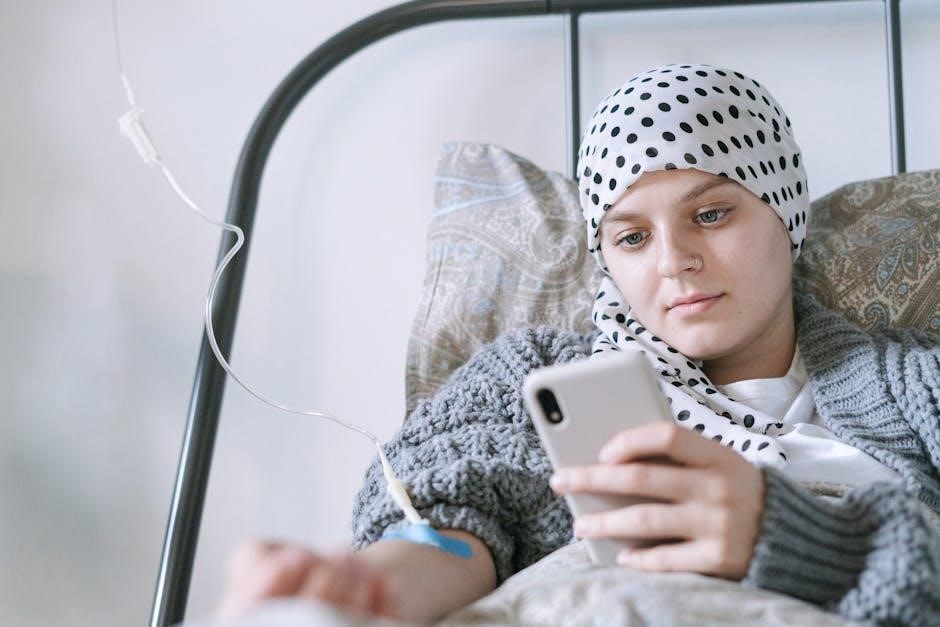Patient positioning PDF guides are essential resources for standardizing surgical and medical practices, ensuring safety and effectiveness. They provide detailed instructions for optimal patient placement, reducing risks like pressure sores or nerve injuries.
1.1 Definition and Importance of Patient Positioning
Patient positioning refers to the precise placement of individuals during medical procedures to ensure safety, comfort, and optimal outcomes. Proper positioning is critical for minimizing complications, such as pressure sores, nerve injuries, and vision loss. It also enhances surgical access, improves anesthesia management, and supports diagnostic accuracy. PDF guides provide standardized protocols for various positions, like supine, prone, and Trendelenburg, ensuring consistency across healthcare settings. Adhering to these guidelines is essential for preventing perioperative risks and promoting patient well-being, making it a cornerstone of modern medical practice.
1.2 Role of PDF Guides in Medical Practice
Patient positioning PDF guides play a vital role in medical practice by offering accessible, sharable, and standardized protocols. These documents provide clear, concise instructions for positioning patients across various procedures, ensuring consistency and reducing errors. They serve as quick reference tools for healthcare professionals, detailing optimal positions for surgeries, diagnostics, and rehabilitation. PDF guides also include visual aids and checklists, enhancing understanding and compliance. Their portability and ease of use make them indispensable resources for maintaining patient safety and improving procedural outcomes in diverse clinical settings.

Surgical Patient Positioning
Surgical patient positioning requires precise attention from the surgical team to ensure safety and optimal outcomes, with detailed PDF guides available to mitigate risks and best practices.
2.1 Overview of Surgical Positions
Surgical positions are standardized to facilitate access, minimize complications, and enhance patient safety. Common positions include supine, prone, lateral, and lithotomy. Each position serves specific surgical needs, guided by PDF resources. Proper alignment and support are critical to prevent injury. Surgical teams must consider patient anatomy, procedure type, and comorbidities when selecting a position. PDF guides provide detailed diagrams and instructions to ensure accuracy. Effective communication among the surgical team is essential for safe positioning. Regular updates in positioning techniques are reflected in PDF materials to align with best practices and advancements in surgical care.
2.2 Supine Position: Benefits and Risks
The supine position, where the patient lies on their back, is widely used in surgeries like abdominal, cardiothoracic, and pelvic procedures. Benefits include easy access to the surgical site, compatibility with anesthesia, and reduced strain on the patient. However, risks such as respiratory compromise due to abdominal pressure on the diaphragm can occur. Prolonged supine positioning may also lead to compartment syndrome or nerve damage. Proper padding and regular repositioning are essential to mitigate these risks. PDF guides often detail optimal positioning techniques to maximize safety and surgical success in this common yet critical position.
2.3 Prone Position: Advantages and Complications
The prone position, where the patient lies face-down, is often used in spinal, spinal, and certain abdominal surgeries. Advantages include improved surgical access to posterior regions, reduced bleeding in some cases, and better alignment of anatomical structures. However, complications such as respiratory compromise, pressure sores, and eye injuries can arise. Proper cushioning and regular monitoring are crucial. PDF guides emphasize padding vulnerable areas like the chest, pelvis, and knees to minimize risks. Despite challenges, the prone position remains a valuable option for specific procedures, with careful planning and execution key to patient safety.
2.4 Trendelenburg Position: Uses and Precautions
The Trendelenburg position involves tilting the patient in a supine position, with their head lower than their pelvis. It is commonly used in abdominal and gynecological surgeries to improve access to pelvic organs. Uses include enhanced surgical exposure and easier manipulation of organs. However, precautions are necessary due to potential complications like respiratory distress, increased intracranial pressure, and nerve injury. Proper cushioning and monitoring are essential to minimize risks. PDF guides recommend limiting the duration and angle of tilt to ensure patient safety while maintaining surgical benefits.

Non-Surgical Patient Positioning
Non-surgical positioning focuses on patient comfort, wound care, and diagnostic accessibility. Proper alignment and support are crucial to prevent complications and promote recovery, ensuring optimal mobility and safety.
3.1 Patient Positioning in Rehabilitation

Patient positioning in rehabilitation is crucial for promoting recovery, preventing complications, and enhancing mobility. Proper alignment reduces pain, improves circulation, and minimizes pressure sores. Techniques like using supportive devices and regular adjustments ensure comfort and safety. Caregivers play a key role in monitoring and adapting positions, especially for patients with limited mobility. This tailored approach helps avoid long-term issues and supports overall well-being, contributing to faster recovery and better outcomes.
3.2 Positioning for Diagnostic Procedures
Patient positioning for diagnostic procedures ensures accurate imaging and minimizes complications. Proper alignment is critical for clear results in X-rays, MRIs, and CT scans. Comfort and safety are prioritized to prevent movement during imaging. Specific positions, such as supine or prone, are used based on the procedure. Supportive devices like pillows or straps may be employed to maintain stability. Correct positioning also reduces radiation exposure and improves diagnostic accuracy. Healthcare professionals must carefully adjust patients to meet the requirements of each imaging modality, ensuring optimal outcomes and patient safety throughout the process.
3.3 Positioning for Comfort and Wound Care
Patient positioning for comfort and wound care is essential for promoting healing and preventing complications. Proper alignment reduces pressure on sensitive areas, minimizing the risk of pressure sores. Techniques like offloading and redistributing weight are used to enhance comfort. Supports such as cushions, wedges, and mattresses help maintain optimal positions. Regular repositioning is critical, especially for immobile patients, to ensure skin integrity. Customized positioning strategies address individual needs, improving patient outcomes and accelerating recovery. This approach also reduces discomfort, enhancing overall well-being and satisfaction during care.

Guidelines for Patient Positioning
Standardized protocols ensure safe and effective patient positioning, minimizing risks and promoting optimal outcomes. Regular staff training and adherence to evidence-based practices are essential for consistency and safety.
4.1 ASA Guidelines for Preventing Perioperative Complications
The American Society of Anesthesiologists (ASA) provides comprehensive guidelines to minimize perioperative risks. These include thorough preoperative assessments, proper positioning techniques, and continuous monitoring of patients during surgery; The ASA emphasizes the importance of maintaining patient safety by avoiding prolonged pressure on vulnerable areas, ensuring adequate ventilation, and preventing excessive stretch or compression of nerves. Adherence to these guidelines helps reduce the likelihood of complications such as nerve injuries, respiratory issues, and skin breakdown. Regular updates to the guidelines reflect advances in medical knowledge and best practices in patient care.
4.2 Best Practices for Safe Patient Handling
Safe patient handling involves a combination of proper techniques, equipment, and teamwork to minimize risks. Using mechanical aids like slides, hoists, and adjustable tables is essential to reduce manual lifting. Staff should be trained in ergonomics and safe lifting practices to prevent injuries. Regular assessment of the patient’s condition and weight ensures appropriate handling strategies. Communication between the patient and healthcare team is crucial to ensure comfort and safety. Implementing these practices reduces the risk of injury to both patients and healthcare providers, promoting a safer care environment.
4.3 Role of Anesthesia in Patient Positioning
Anesthesia plays a vital role in patient positioning by ensuring the patient remains still and pain-free during procedures. This allows for precise positioning necessary for surgical access. Collaboration between anesthesiologists and surgeons is crucial to determine the optimal position, considering the patient’s physiological status. Anesthesia supports the patient’s airway, ventilation, and circulation throughout the procedure. Proper positioning under anesthesia also involves using supportive devices to prevent complications like nerve injury or pressure sores. Continuous monitoring by the anesthesia team helps maintain patient safety and comfort, ensuring successful surgical outcomes and minimizing risks effectively always.
Equipment and Tools for Patient Positioning
Specialized equipment like surgical tables, positioning aids, and safety straps are essential for maintaining patient stability and alignment during procedures. These tools ensure precise positioning, enhancing surgical accuracy and patient safety, while minimizing risks of complications.
5.1 Surgical Tables and Accessories
Surgical tables are central to patient positioning, offering adjustable features like height, tilt, and rotation to accommodate various procedures. Accessories such as headrests, armboards, and leg holders enhance customization, ensuring proper alignment and support. These tools are designed to maintain patient stability, optimize surgical access, and reduce the risk of complications. Modern tables often feature ergonomic designs for ease of use, while accessories may include padding or straps to ensure patient safety and comfort during long procedures. Proper use of these tools is critical for maintaining patient safety and procedural efficiency in the operating room.
5.2 Positioning Aids and Devices
Positioning aids and devices are essential for maintaining optimal patient alignment during procedures. These include cushions, straps, and supports designed to stabilize specific body parts. For example, chest rolls and gel pads are used to protect pressure points and improve circulation. Adjustable straps and clamps help secure patients in complex positions, reducing movement risks. These tools are tailored for various surgical specialties, ensuring precise patient placement and minimizing complications. Their versatility and adaptability make them indispensable in modern medical practice, enhancing both patient safety and procedural efficiency. Proper selection and use of these aids are critical for achieving desired outcomes.
5.3 Use of PDF Guides for Equipment Setup
Patient positioning PDF guides play a crucial role in equipment setup by providing detailed, visual instructions. These guides ensure that surgical tables, positioning aids, and accessories are configured correctly for specific procedures. They often include diagrams and step-by-step instructions to optimize equipment placement, reducing setup time and improving efficiency. PDF guides also highlight safety considerations, such as securing straps and stabilizing devices, to prevent patient movement during procedures. Their standardized approach minimizes errors and enhances reproducibility across different cases. Regular updates in these guides reflect advancements in equipment design and positioning techniques, ensuring healthcare professionals stay informed and compliant with best practices.

Complications and Risks
Improper patient positioning can lead to complications such as pressure ulcers, nerve damage, and respiratory distress. Awareness of these risks is critical for preventing long-term harm.
6.1 Pressure Sores and Skin Integrity
Pressure sores, also known as pressure ulcers, are a common complication of improper patient positioning. Prolonged pressure on soft tissues can impair blood flow, leading to skin breakdown and underlying tissue damage. High-risk areas include the sacrum, heels, and elbows. Prevention involves regular repositioning, using supportive padding, and ensuring proper alignment. PDF guides emphasize the importance of assessing skin integrity and implementing measures to reduce pressure points. Early detection and intervention are critical to avoid severe complications, such as deep tissue injury or infection. Proper positioning strategies can significantly minimize the risk of pressure sores and promote patient comfort.
6.2 Nerve Injuries and Neurological Complications
Nerve injuries and neurological complications can arise from improper patient positioning during medical procedures. Prolonged compression or stretching of nerves can lead to conditions such as neuropathy or paresthesia. Commonly affected areas include the brachial plexus, ulnar nerve, and peroneal nerve. Factors such as excessive pressure, improper alignment, or prolonged immobility increase the risk. PDF guides recommend regular neurological assessments and careful positioning to minimize these risks. Anesthesia-induced paralysis can exacerbate nerve vulnerability, making proactive positioning strategies crucial. Early detection and correction of nerve compression can prevent long-term neurological damage and improve patient outcomes significantly.
6.3 Vision Loss and Eye Care
Vision loss and eye complications can occur due to improper patient positioning, particularly during prolonged procedures. Pressure on the eyeballs or inadequate protection can lead to corneal abrasions or retinal damage. Patients under general anesthesia are at higher risk due to inability to blink. PDF guides emphasize the use of protective eyewear or eye guards, especially in prone or Trendelenburg positions. Regular monitoring of eye health during procedures is crucial. Anesthesia teams must ensure proper eye positioning and protection to prevent long-term vision impairments. Prompt intervention and adherence to guidelines can minimize these risks and safeguard patient vision effectively.

Special Patient Populations
Patient positioning must address unique needs of pediatric, geriatric, and obese populations. Anatomy, health conditions, and vulnerabilities require tailored approaches to ensure safety and optimal outcomes.
7.1 Pediatric Patient Positioning
Pediatric patient positioning requires careful consideration of age-related anatomical and physiological differences. Proper positioning ensures safety, comfort, and optimal surgical or procedural outcomes. In pediatric care, smaller body size and developing musculoskeletal systems demand specialized equipment and techniques. Supportive devices, such as pediatric-sized tables and cushions, are essential to prevent injury and promote stability. Positioning must also account for growth plates and delicate tissues to avoid long-term complications. Additionally, maintaining proper alignment and ensuring adequate respiratory space are critical, as children are more prone to respiratory distress. Customized approaches tailored to each child’s size and condition are vital for successful patient positioning.
7.2 Geriatric Patient Positioning
Geriatric patient positioning requires careful attention to age-related physical changes, such as limited mobility, joint degeneration, and fragile skin. Proper positioning is essential to prevent discomfort, pressure sores, and complications. Supportive devices, like cushions and wedges, are often used to maintain alignment and reduce strain on joints. Special consideration is given to conditions like osteoporosis and arthritis, which may limit certain positions. Gentle handling and gradual movements are crucial to avoid injury. Additionally, ensuring adequate padding and maintaining proper respiratory alignment are key to promoting patient safety and comfort during procedures.
7.3 Obese Patient Positioning

Obese patient positioning requires specialized techniques to ensure safety and comfort. Bariatric equipment, such as reinforced tables and larger cushions, is essential to support excess weight. Positioning strategies focus on maintaining proper alignment while minimizing pressure points. Careful attention is given to respiratory function, as obesity can compromise breathing. Weight distribution must be even to prevent pressure sores and nerve damage; A multidisciplinary team approach is often necessary to safely position and reposition obese patients. Proper planning and continuous monitoring are critical to avoid complications and ensure optimal outcomes during medical procedures.

Legal and Ethical Considerations
Informed consent, patient rights, and malpractice liability are critical. Proper documentation and adherence to ethical standards ensure accountability and minimize risks during patient positioning procedures.

8.1 Informed Consent and Patient Rights
Informed consent is a legal and ethical cornerstone, ensuring patients understand and agree to their care. Patients have the right to autonomy, dignity, and full disclosure of risks, benefits, and alternatives. Healthcare providers must obtain explicit consent before procedures, respecting patients’ decisions. This process fosters trust and ensures ethical practice; In patient positioning, consent must address potential risks like nerve damage or respiratory compromise. Clear communication is vital, with documentation maintaining transparency and accountability.
8.2 Malpractice and Liability in Positioning
Malpractice in patient positioning occurs when negligence leads to avoidable harm. Liability arises if healthcare providers fail to adhere to established protocols, resulting in complications. Proper training, equipment, and adherence to guidelines are essential to minimize risks. Institutions must ensure staff competence and maintain accurate documentation. Failure to do so can lead to legal consequences. Standardized positioning protocols protect both patients and providers, reducing liability. Regular updates to practices and continuous education are vital to prevent malpractice claims and ensure patient safety.
8.4 Documentation and Reporting
Accurate documentation and reporting are critical in patient positioning to ensure accountability and continuity of care. Detailed records of the position used, rationale, and any precautions taken must be maintained. This documentation serves as a legal safeguard and helps in auditing. Reporting any positioning-related incidents ensures transparency and compliance with regulations. Timely and precise documentation also aids in tracking patient outcomes and improving future practices. Proper reporting mechanisms help identify systemic issues and prevent recurrence, ultimately enhancing patient safety and institutional integrity.
Patient positioning PDF guides enhance safety, standardization, and outcomes. Future advancements will focus on integrating technology for real-time monitoring and improving accessibility through digital platforms.
9.1 Summary of Key Points
Patient positioning is critical for ensuring safety, optimizing outcomes, and minimizing complications. Proper positioning enhances surgical access, reduces pressure injuries, and improves patient comfort. PDF guides play a vital role in standardizing practices, offering clear, accessible instructions for healthcare professionals. Surgical positions like supine, prone, and Trendelenburg each have specific benefits and risks. Non-surgical applications, such as rehabilitation and diagnostic procedures, also rely on precise positioning. Guidelines from organizations like ASA emphasize preventive measures, while equipment and tools support safe handling. Special populations require tailored approaches, and legal considerations highlight the importance of informed consent and documentation. Continuous advancements aim to refine techniques and integrate technology for better patient care.
9.2 Advancements in Patient Positioning
Recent advancements in patient positioning focus on enhancing precision, safety, and comfort. Robotics and AI-driven systems now assist in optimizing positions, reducing human error. 3D modeling and simulation tools enable preoperative planning, improving surgical outcomes. Adjustable surgical tables with advanced tilting and lifting mechanisms minimize strain on patients and staff. Pressure-sensing mats help detect and prevent pressure sores in real time. Additionally, augmented reality is being explored to guide positioning during complex procedures. These innovations aim to improve patient safety, streamline workflows, and integrate seamlessly with existing PDF guides for better adherence to best practices.



